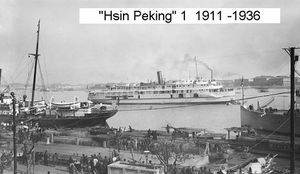Hsin Peking I
Test
Contents
History
The first of a class of three vessels, the other two being the "Luen Ho" and "Luen Yi".
1906. Built as the "Li-Ta" for Cie Asiatiqe de Navigation, Dunkirk. with Racine Ackermann & Co. Shanghai, as managers. This was one of the three ships built for their Yangtse river services. The other two identical vessels being originally called the "Li-Mao" and the "Li-Fong". However the ships were too large for the Francophile community and the venture was a financial disaster.
June 1911. Racine Ackermann & Co, were declared bankrupt.
October 1911. The agency was taken over by a by a joint venture consisting of the China Navigation Co., (Butterfield & Swire), the Indo-China Steam Navigation Co., (Jardine, Matheson), and the China Merchants Steam Navigation Co., which operated the same services. The Yangtse river services was a very competitive market so the objective of the consortium was to prevent a new competitor entering the market. Each company had a one third equity in the venture and were each the owner of one ship. The three vessels operated the daily 4pm. sailing from Shaghai to Ningpo, from the original departure point on the French Bund.
October 1911. The "Li-Tah" was renamed "Hsin Peking" by C.N.Co.
March 1936. Sold to Shipbreakers in Osaka.
Service
Events / Stories
"Hsin" is the Wade Giles transliteration of the adjective 新, "new", "up to date". The Pinyin transliteration is "xin".
The original "Pekin" was withdrawn and hulked when the "Hsin Peking I" entered service, on the same run. The idea was to retain the original ship's loyal following amongst passengers.
This naming policy has been, and still is, common with other East Asian owners, but this seems to have been the only case of CNCo making use of it.

